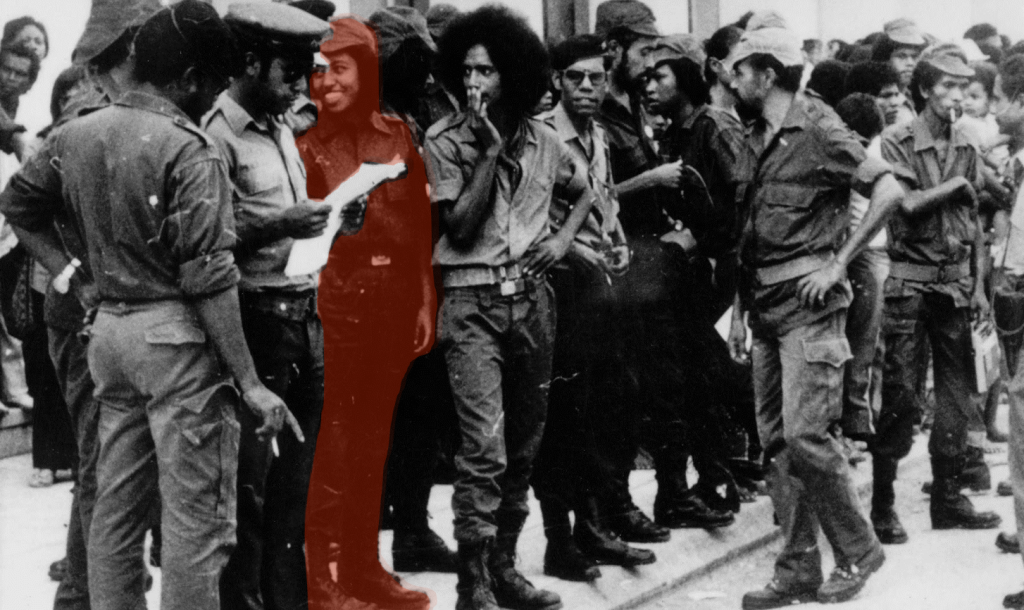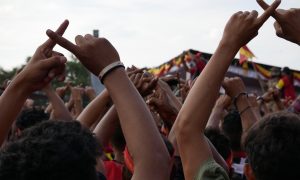When East Timor gained its independence in May 2002, after a 24-year struggle against Indonesian occupation, how to compensate those who fought was one of the first decisions the new government had to make. By September of that year, two commissions had been established to register veterans of the armed struggle. Almost 40,000 people registered at the time, and a further 76,000 registered when another commission was established two years later. Veterans’ benefits are a sensitive issue in East Timor. Misgivings about favouritism were partly behind the 2006 violence that spread throughout the nation, while a significant chunk of the state budget is still today handed over for pensions, not without politically-motivated reasons.
But more aggrieved than most were the women of East Timor. In the first two commissions, out of 36,959 registered individuals only 13 were women. At the 2004 commission, which was intended for those who had fought in the clandestine resistance, 10,337 of the 76,061 registered were women—roughly 13%. This is despite some estimates that as many as 60% of the clandestinos (as they are known) were female.
On August 6, 2010, Lourdes Maria Alves de Araujo, Secretary General of the Popular Organisation of East Timorese Women (OPMT), brought attention to this issue. “It is now ten years since we have restored our independence but the leaders have forgotten the contribution and values [that women brought to the independence struggle],” Araujo began. Did the legacy of the women who died during the independence struggle die with them, she then asked, and will their recognition be only that “as the wife of a deceased combatant or cadre? If so, this is unfair, particularly when we want to create a complete history of our people.”
When I visited Dili in 2015, an idle afternoon provided me the time to wander the city. Under a sedulous sun, I stopped to rest in a small, unassuming park that I later discovered is dedicated to Rosa “Muki” Bonaparte Soares, a little known but important figure of the early nationalist movement. Back home, I consulted the books I own on East Timorese history: Bonaparte’s name arose only in either a long list of other names from the period or as a passing reference to her stewardship of the OPMT. Academic essays bore more fruit. Perhaps the finest exploration of Bonaparte’s life, and of the East Timorese women’s movement during the 1970s, is Hannah Loney’s essay, “The Target of a Double Exploitation: Gender and Nationalism in Portuguese Timor, 1974–75”, published in 2015.
“Previous studies of early East Timorese nationalism have not adequately accounted for the roles and experiences of women within the formation of nationalist ideology and in practice,” Loney wrote, adding that when these experiences are assessed, women’s “participation is an aside to the wider nationalist movement and to the unfolding story of Indonesian oppression”.
While undeniably true, Bonaparte also best embodies the problems faced by female participants in the independence struggle—first against Portugal, then Indonesia—for the simple reason that she knew sectarian issues (namely women’s emancipation) were at the same time hindering and intrinsic to the struggle.
Bonaparte was born in Manatuto, a small city on the northern coast, about 70 kilometres from the capital. (I am unable to locate her date of birth though it must in the records in Dili). After graduating from a Canossian school she earned a scholarship to study in Lisbon in the early 1970s. At the time East Timor had been under Portuguese colonisation since the beginning of the 18th century. Completing an introductory course in commerce, she gravitated towards political activism, joining the Movimento Reorganasative de Proletariat Portuguese (MRPP), a Maoist group dwarfed by Soviet-backed Portuguese Communist Party. The East Timorese student population in Lisbon, at the time, must have been claustrophobic. Forty at the most, many lived together in a house in the city’s suburbs they named Em Casa Timor. Here, the Timorese students, including Bonaparte, met regularly to discuss politics and anticolonial activism, often joined by dissidents from other Portuguese territories, like Angola and Mozambique.
Life, however, was interrupted on 25 April 1974, when military officers ousted the Portuguese leader Caetano in what became known as the Carnation Revolution. It was clear from then on that the sun was finally setting on the Portuguese empire. The Carnation Revolution allowed, for the first time, East Timorese political parties to come out in the open as legal entities. One, the Timorese Social Democratic Association (ASDT), took up the mantle of autonomy and independence. The Timorese Popular Democratic Association, however, favoured integration with Indonesia, while the Timorese Democratic Union preferred continued relations with Lisbon.
Bonaparte returned home in September 1974, the same month the ASDT changed its name to the Revolutionary Front for an Independent East Timor, or FRETILIN. She was among many former Em Casa Timor students who took part in FRETILIN’s grass roots mobilisation and, known for her oratory skills, participated in the negotiations with the Portuguese Decolonisation Commission in Dili in May 1975. It has been said that on 28 November 1975, when FRETILIN made its proclamation of independence from Portugal, Bonaparte was the one to unfurl the brand new flag of the Democratic Republic of East Timor.
Bonaparte was one of only three women—along with Maria do Céu Pereira and Guilhermina Araújo—to be part of FRETILIN’s original 50-strong central committee. And, on 28 August 1975, she was named Secretary General of the first East Timorese women’s organisation, the OPMT. It wasn’t long before organisation chapters spread across the half-island nation, with 7,000 members within weeks. Free classes were provided to illiterate women and, for the first time, taught in the Timorese language, Tetum, and crèches were established for child-care.
However, Bonaparte’s life, like East Timor’s first taste of independence, was cut short. On 17 December 1975, Indonesian forces invaded. The following day, Bonaparte and a colleague, Isabel Barreto Lobato, the wife of Nicolau Lobato, were taken to the waterfront in Dili and shot. Jill Jollife, an Australian journalist who witnessed the invasion, wrote:
“They [the Indonesian soldiers] were dragging women on to the barges. One woman wouldn’t go. She was Muki… Small, intense, very Timorese, the Portuguese called her “the petite revolutionary” and “Rosa Luxemburg” for her contribution to the talks. When she resisted the Indonesians she was shot on the wharf and her body thrown into the harbour.”
Of the few photographs of Bonaparte that exist, by far the most illustrative is one taken by Jolliffe in 1975. Standing alongside Mari Alkatiri, Nicolau Lobato and Mau Laka—the senior figures of FRETILIN—Bonaparte stares off in the distance, her head covered by a small white hat. Most of the surviving photos from this period are of men in action, with prim fatigues and rifles dangling from the shoulder, but in this photograph they are motionless and defiant more. Bonaparte stands as tall as Mari Alkatiri, making the “petite revolutionary” moniker slightly more patronising, and clichéd, than heartfelt.
Interesting, too, if Bonaparte was ever known affectionately as “Rosa Luxemburg” it would have been as much a compliment as an encumbrance. A Polish-born communist, Luxemburg was one of the most original Marxist thinkers of her time, so much so that people would once deemed themselves to be Luxemburgists. She too was killed before her prime, shot dead by the German Freikorps in 1919. And, with an instance of history’s unfortunate repetition, her body was also dumped into water: Berlin’s Landwehr Canal.
While Luxemburg left behind a considerable body of work, Bonaparte’s surviving oeuvre consists of a few articles written for the Jornal do Povo Maubere, the FRETILIN newspaper, and another, first published in a Trotskyist journal, which was later reprinted by the Australian solidarity movement bulletin, East Timor News, two years after her death. However, her finest words are found in a manifesto she published on 27 September 1975, for the OPMT. Entitled “Analysis of the Situation of Timorese Women”, it was the only known document which established a theoretical basis for the struggle of East Timorese women at the time. She wrote:
“It is incredible that in a country where more than 50 percent of the population consists of women, that they would not take part in the liberation struggle…To participate in combat does not just mean to take up arms, though this is superior. The participation of Timorese women in the fighting takes various forms: gather information about enemy movements, their fighting potential, and so on.”
Here, of course, she was not talking about the resistance against the Indonesian occupation (she knew only one day of that) but of the struggle against Portugal and for FRETILIN’s survival in power. Nonetheless, she was prescient for what was about to come. FRETILIN, itself, was divided about the “proper” role women should play in the independence struggle. Rogerio Lobato, a FRETILIN Central Committee member and Commander-in-chief of FALINTIL, its armed wing, said in a 1978 interview:
“Many people cannot understand that women should take up arms against the Indonesians. They see women as only in traditional roles; looking after the house, rearing children, and so on… But women form half the population and they must be involved in the struggle on all fronts, including the armed struggle.”
As mentioned earlier, Bonaparte acknowledged that armed combat was a “superior” form of participation. Nonetheless, she thought women’s participation in the armed resistance was not just a means of relinquishing their traditional roles, but that the struggle was a way in which traditional roles would be expunged altogether. An emancipatory consciousness would be found through the struggle and emancipation achieved once national freedom was assured. However, as with other women engaged in nationalist activity, her thoughts were sensitive to questions of priorities and the possibility of sectarian values interfering with the common goal. In her 1975 manifesto, she stated:
“The principal objective of women participating in the revolution is not, strictly speaking, the emancipation of women as women, but the triumph of the revolution, and consequently, the liberation of women as a social being who is the target of a double exploitation: that under the traditional conceptions and that under the colonialist conceptions”
Here, it is not clear what “revolution” she was speaking about: a ‘national’ revolution for independence or a ‘socialist’ revolution. She almost certainly had Marxist sympathies, given her political education in Lisbon in the mid-1970s when she joined the Maoist MRPP, and her participation with the leftist FRETILIN (though it would only formally adopt a Marxist-Leninist platform in 1977, supposedly from pressure by Roque Rodrigues and Antonio Carvarinho, also members of the MRPP in Lisbon).
Still, Bonaparte was correct that Portuguese colonisation enforced strict gender roles in society. Before the Europeans’ arrival, distinctions between work and housework (or male work and female work) were hardly existent, though this isn’t to say in pre-Portuguese Timor there was genuine equality. But the gendered division of labour was enforced early by Portuguese missionaries and, come the era of Fascist Portugal, only worsened. Timorese men were conscripted into labour forces, Bonaparte wrote, separating women from their husbands, leaving them to care for the children and without the means to raise them. By removing colonial powers, she thought it would also expel the mindset the colonialists had instigated, allowing for the blossoming of a new culture. However, as many East Timorese women know today, it was possible for colonisation to be defeated without traditional concepts of gender also being erased.
Something else that catches the eye is Bonaparte’s view on the actual praxis for bringing about gender consciousness among East Timorese women. A number of the MRPP activists in Lisbon supported the beliefs of the Guinea-Bissauan intellectual Amílcar Cabral, who, in what he called “class suicide”, believed that the bourgeois revolutionary should destroy all vestiges of his or her own class. It was pure Maoism. But as only one of three female members of FRETILIN’s original central committee, Bonaparte might, in modern parlance, be described as an “elite”. Indeed, she was of relatively privileged birth and fortunate enough to be educated at the women’s schools run by Italian Canossian missionaries. (The first school for women in Portuguese Timor was opened by the Canossians in 1902 in Ainaro, a small mountain town on the southern coast.) She also received a scholarship to study in Lisbon, an opportunity available for only a few dozen Timorese at the time.
In her 1975 manifesto, she wrote that it was the responsibility of “the more active and conscious women” to “awaken those [women] who are passive and submissive.” This vanguard theory of female political awakening reflected in FRETILIN’s vanguard position of the independence struggle (another indication of Marxist-Leninist roots). It has a lasting legacy in the modern day discussion on gender equality in East Timor.
Despite boasting one of Asia’s highest percentages of female parliamentarians (38% at the last count, though it likely increased at last month’s general election) many have put this down to affirmative action laws that require a percentage of female candidates to stand in elections. A law introduced in 2006, for example, requires political parties to nominate one woman for every group of four candidates at national elections. Does this, some ask, just merely create an appearance of progress?
In a 2011 paper, “Hakat Klot, Narrow Steps”, Sara Niner, an anthropologist at Monash University, wrote, “although Timor has one of the highest levels of female parliamentary participation in the world, many of these women are often ineffective and viewed merely as token representatives (possibly forced on the Timorese by the idea of a foreign quota system).” Moreover, Niner added: “There is often tension within the women’s movement about… priorities and a divide between less-educated rural women and middle class urban women with a more feminist agenda.” Bonaparte was not one to confuse compassion with patronising. She was clear: it was the duty of the more educated to raise the consciousness of the lesser-educated. Backwardness and tradition were the impediments to emancipation of women and just as essential to be expunged as the vestiges of colonisation, she thought.
Perhaps—too Marxist in her overtones; too concerned with nationhood than gender identity; too utopian—her words and thoughts appear somewhat atavistic today. Though, by no means are they to be ignored nor overlooked. And in plaintive awareness of what Perry Anderson once called the “history of possibility”, one cannot read Bonaparte’s writings without the fanciful imagination of what she might have been able to add to the struggle against Indonesian occupation (and East Timor’s democracy today) if she wasn’t one of its first casualties.
……………
David Hutt is a journalist and writer based in Phnom Penh. He is also the Southeast Asia Columnist for The Diplomat, and a contributor to numerous regional publications. You can follow him on Twitter at @davidhuttjourno.
 Facebook
Facebook  Twitter
Twitter  Soundcloud
Soundcloud  Youtube
Youtube  Rss
Rss 


